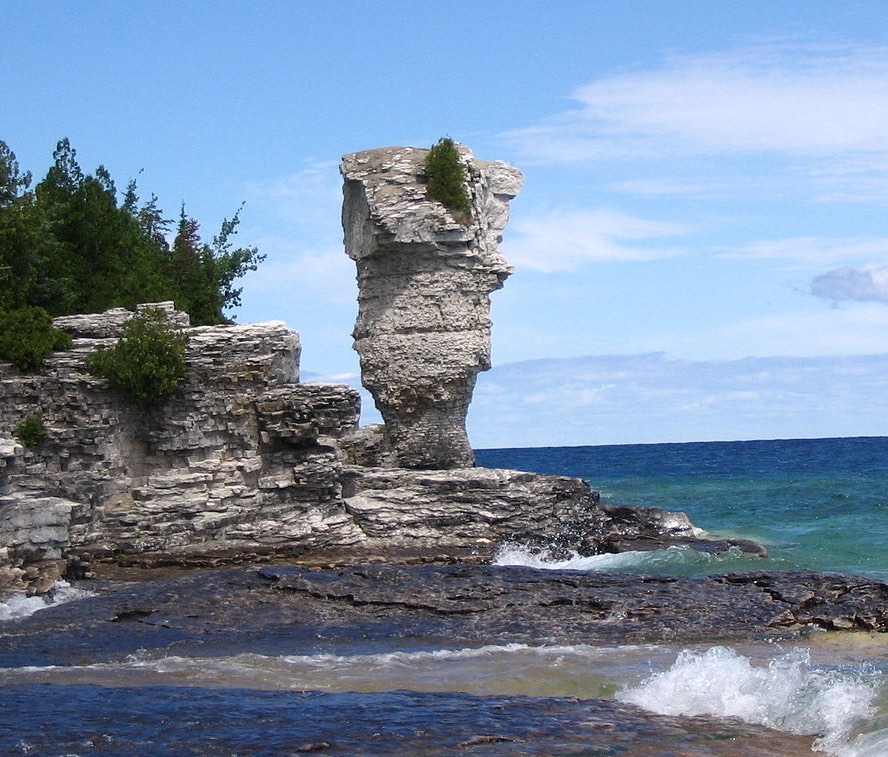Quick links
flowerpot
DCHP-2 (Sep 2012)
Spelling variants:flower-pot, Flower-pot, Flowerpot
n. — Outdoors
a rock formation created by erosion; often used in the compound flowerpot rock. See Image 1.
Type: 3. Semantic Change — The term flowerpot refers to a tall rock formation that is particularly eroded near its base (see the 1967 quotation and image 1). Flowerpot rocks are detached portions of cliff faces that form as a result of wind and water erosion; they are found especially in Georgian Bay, Ontario, and the Bay of Fundy, between New Brunswick and Nova Scotia (see COD-2, s.v. "flowerpot" (2)). The earliest found attestation of flowerpot is in reference to Flowerpot Island (see the 1849 quotation), a national park located in the Bruce Peninsula, Ontario, and home to many flowerpot rock formations (see the 1949 and 1967 quotations). As seen in Chart 1, the term is most frequently used in Canada; note that many Australian and New Zealand sources (see Chart 1) are discussing Flowerpot Rocks, an island in American Samoa, and not a type of rock in general. Moreover, the majority of non-Canadian sources appear to be tourism sites referring to flowerpot rocks in Canada.
See also COD-2, s.v. "flowerpot" (2), which is marked "Cdn".
See also COD-2, s.v. "flowerpot" (2), which is marked "Cdn".
Quotations
1849
On some parts of the coast, the rock is worn by the action of the water of the lake into remarkable pillar-like shapes. This is particularly the case at Flower-pot Island, where one column was observed (the height of which we could not ascertain, as it was only viewed from the boat,) resembling a jelly-glass, being worn small near the base and enlarging symetrically [sic] toward the top.
1859
These were divided into two classes, the first comprising caverns which are at the present time washed by the waters of lakes, seas, and rivers, including arched, perforated, flower-pot, and pillared rocks, which have at one time formed the boundaries or walls of caverns, and all of them the result of aqueous action. [...] Amongst the most remarkable which were noticed, were the arched rocks at Perce, Gaspe; the flower-pot rocks of the Mingan Islands; [...]
1860
On its west side, a mile to the northward of its south-west point, there are many flowerpot and arched rocks, standing on the flat limestone above the present high-water mark.
1930
It is situated at the north end of the Bruce Peninsula, and gets its name for the two rock rock formations that resemble large flowerpots. [...] The National Park will now have twenty-eight or twenty-nine islands in Georgian Bay for the use of the public. Flowerpot Island was surrendered by the Chippewa Indians in 1856, and has been held in trust recently by the Department of Indian Affairs, to which the Parks Branch will pay $165 for it.
1949
New 'Flowerpot' Discovered On Bruce Peninsula Coast [...] Bruce Peninsula, famous for the peculiar flowerpot rock formations of Flowerpot Island, has another rock flowerpot, almost hidden until now.
1967
We went to find the Devil's Pulpit, following the road south from Dyers Bay and turning onto a side trail where the signs indicated. The flowerpots of Flowerpot Island are detached portions of the cliff face 30 to 50 feet high. The bases of them have been eroded by wave action until they are much smaller in girth than the top. Small trees that grow on the top give the formations their name.
1989
After a morning meandering along the southeast shore of New Brunswick, where the Bay of Fundy tides are at their most dramatic, often rising as much as 13 metres in six hours, we had stopped for lunch at The Rocks Provincial Park near Hopewell Cape. Here the awesome tides have carved flowerpot rock formations out of the cliff-like shoreline, and the provincial government has built an 18.5-metre stairwell down the embankment so that visitors may have a close-up view of the tides' work.
1999
When the tides are low, you can wander out on the ocean floor for a close look at New Brunswick's famous "flowerpot" rocks - huge, fir-topped sandstone columns, some reaching as high as 100 feet above the beach, that have been sawed off from the main cliffs by water and wind erosion.
References
- COD-2
Images
Chart 1: Internet Domain Search, 16 Jul. 2014
